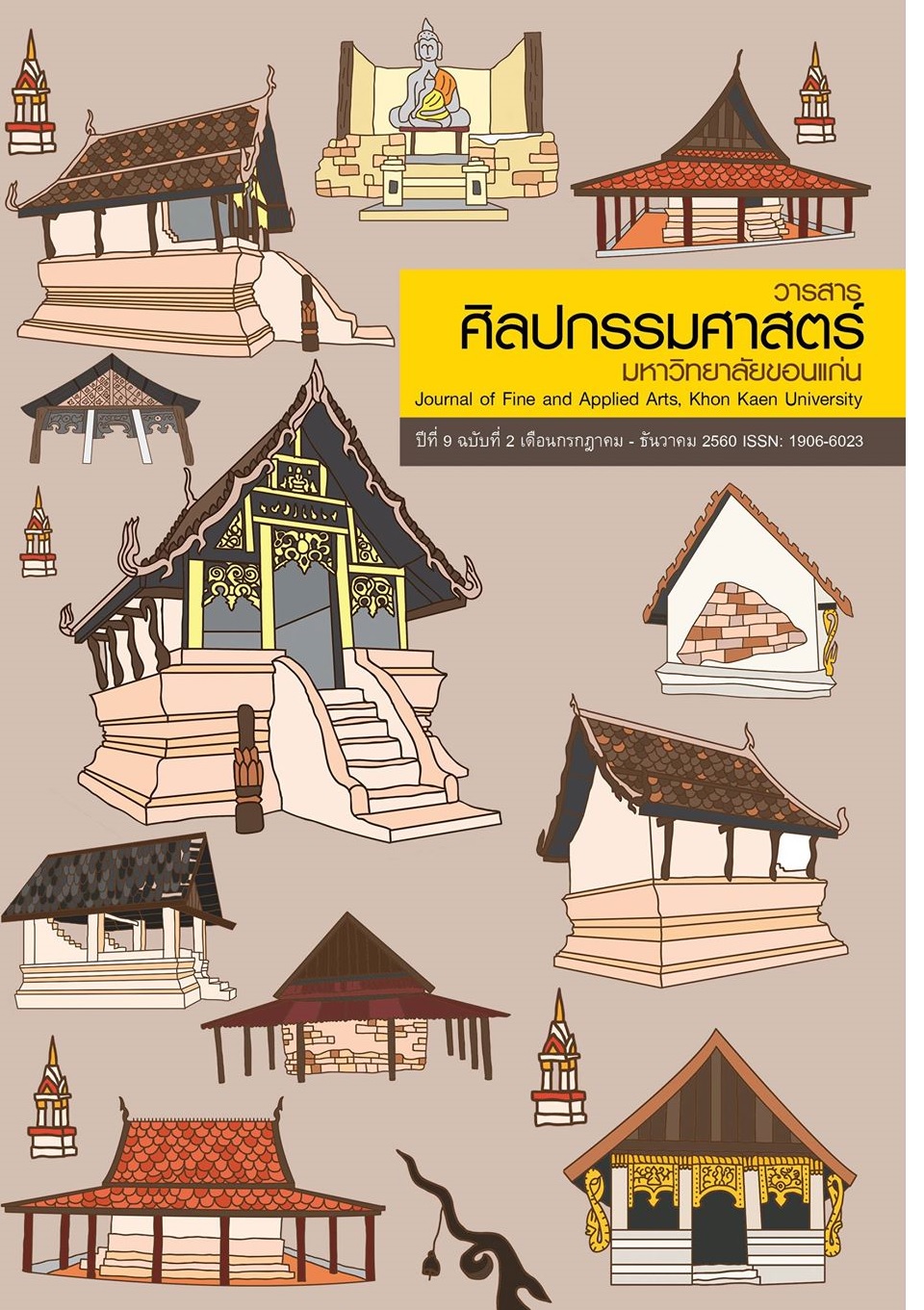คุณลักษณะทางดนตรีไทลื้อในลุ่มน้ำโขง Tai lue Music in Maekong basin
Main Article Content
Abstract
งานวิจัยเรื่องนี้มีความมุ่งหมายเพื่อศึกษา 1. คุณลักษณะทางดนตรีของชาวไทลื้อในลุ่มน้ำ-โขง 2. เพื่อศึกษาบทบาท หน้าที่และการเปลี่ยนแปลงดนตรีของชาวไทลื้อในสังคมลุ่มน้ำโขง จำนวน 3 ประเทศ ได้แก่ สาธารณรัฐประชาชนจีน สาธารณรัฐแห่งสหภาพเมียนมาร์ และสาธารณรัฐ-ประชาธิปไตยประชาชนลาว โดยใช้วิธีการศึกษาจากเอกสารและภาคสนามด้วยการสังเกตและสัมภาษณ์จากผู้รู้ นักแสดง นักดนตรี และผู้ชม นำเสนอผลการศึกษาวิทยานิพนธ์ด้วยวิธีการพรรณนาวิเคราะห์ ผลการศึกษาปรากฏดังนี้
เกี่ยวกับคุณลักษณะทางดนตรีของชาวไทลื้อในลุ่มน้ำโขง เครื่องดนตรีที่พบคือ ปี่ลื้อเป็นเครื่องดนตรีใช้ประกอบการขับลื้อ ปี่น้ำเต้าเป็นที่นิยมอย่างแพร่หลายในสาธารณรัฐประชาชนจีน จังหวะของดนตรีไทลื้อเป็นจังหวะช้าในช่วงเกริ่นการขับลื้อ จังหวะปานกลางในช่วงของการขับลื้อ ท่วงทำนองมีเสียงหลัก 5 เสียงคือ C D E G A เสียงประสานดนตรีในบทขับลื้อ ปี่ลื้อเป็นเครื่องดนตรีในการเดินทำนองประสานเสียงประกอบกับคำร้องตลอดเพลง
เกี่ยวกับบทบาทหน้าที่ดนตรีของชาวไทลื้อ การขับลื้อ การขับลื้อจะมีหน้าที่ไปแสดงในงานประเพณีที่สำคัญ เช่น งานแต่งงาน งานขึ้นบ้านใหม่ งานบวชลูกแก้ว งานสงกรานต์ และเพื่อการท่องเที่ยว บทบาทหน้าที่ดนตรีของชาวไทลื้อในด้านคุณธรรมจริยธรรม ในบทเพลงกล่าวถึงการใช้ชีวิต คำอวยพรต่าง ๆ ซึ่งล้วนแล้วแต่สอดแทรกแนวคิด วิธีคิด สิ่งที่ดี เพื่อเพิ่มเติมเกิดเป็นความรู้ที่สำคัญในบทบาทหน้าที่ด้านคุณธรรมจริยธรรม บทบาท หน้าที่ดนตรีของชาวไทลื้อในสังคมรับใช้ในงานบุญประเพณีต่าง ๆ และเพื่อการท่องเที่ยวสามารถสร้างรายได้ให้กับชาวไทลื้อและผู้คนที่อยู่ในบริบทสังคมรอบ ๆ ที่มีการค้าเครื่องดนตรีและสินค้าอื่น ๆ ขายระหว่างกัน
เกี่ยวกับการเปลี่ยนแปลงดนตรีไทลื้อนั้นมีการรับเอาวัฒนธรรมอื่น ๆ ที่ไม่ใช่วัฒนธรรมไทลื้อเข้ามาประสมประสาน ดนตรีไทลื้อในลุ่มน้ำโขงจะมีการนำดนตรีตะวันตกเข้ามาบรรเลงด้วย ได้แก่ กีตาร์ เบส คีย์บอร์ด กลองชุด แต่คำร้องก็ยังเป็นการขับลื้ออยู่เช่นเดิม แต่ก็มีสำเนียงออกไปทางประสมประสานกับภาษาในแต่ละท้องถิ่นประเทศ
This study aimed to explore 1. Features the music of Tai Lue in the Mekong. 2. To study the role The change of musical acts and Tai Lue in the three Mekong countries, including USA, China. The Republic of the Union of Myanmar and Laos. Using the documentation and field observations and interviews with those who know the actors, musicians and the audience. The thesis presents the results of a study by the descriptive analysis. The results were as follows:
About the musical feature of Tai Lue in the Mekong. Musical entertainment is driving Leu Leu year later, the music of Lue will join other instruments such as the fiddle, bagpipes for fun gourds on a key board, guitar driven songs with melodies and traditional Lue. In addition, the soundtrack of the Tai Lue in Laos has introduced various instruments into the mix. In a musical chorus Leu Leu, including marimba, clarinet, guitar, bass, drum kit, Canon instrument is an instrument similar to a clarinet and the main melody is inflicted by the use of various harmonic accompaniment to any music application.
About the role of the musical drive Lue Lue Lue drive will have to perform at important traditions such as weddings, house warming. Ordination plexiglass Songkran water and to tour the musical role of Tai Lue in the field of ethics. In the song of life. Greeting, which are inserted in the way a good thing to know is more important role in the moral role of music in society Lue been used in various religious traditions. And tourism can generate revenue to the Tai Lue, and the people in the social context surrounding the trade between them.
Lue musical about changes that have embraced other cultures. Lue culture than to merge. In the People's Republic of China Whether the music he played with guitar, bass, keyboards and drums, but also as a petition remaining the same. It has the accent to the combination of the local language of each country.
Article Details
Content and information in articles published in the Journal of Fine and Applied Arts of Khon Kaen University is regarded as the opinion and sole responsibility of the author(s) directly; therefore, editors are not obliged to agree to or share any responsibility with regard to the content and information that appears within these articles.
All articles, information, content, image, etc. that have been published in the Journal of Fine and Applied Arts of Khon Kaen University is the copyright of the Journal of Fine and Appllied Arts of Khon Kaen University. Any person or organization who wishes to distribute all or parts of the articles for further dissemination or other usage must first receive permission from the Journal of Fine and Applied Arts of Khon Kaen University before proceeding to do so.

